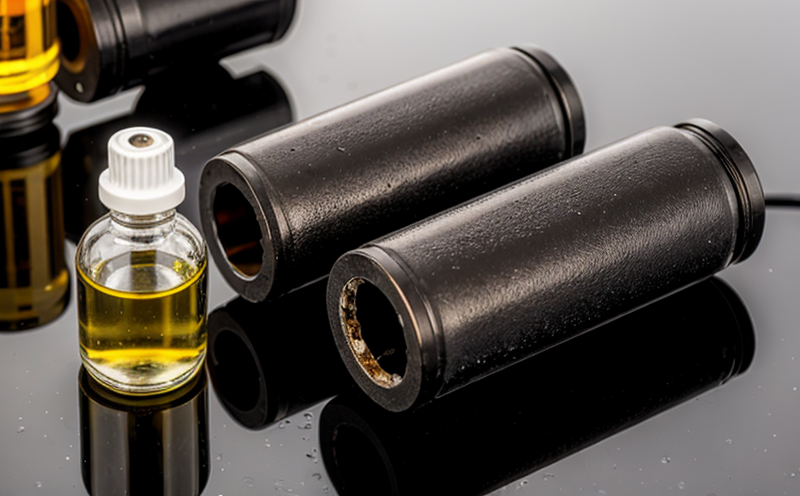EPA 1664A Oil and Grease Gravimetric Test in Water
The EPA 1664A method is a standardized procedure for the quantitative analysis of oil and grease in water samples. This gravimetric test ensures accurate measurement by quantifying the solid matter that settles out after acidification, which can be attributed to hydrocarbons, animal or vegetable fats, waxes, oils, greases, and certain solvents.
Oil and grease contamination in water sources is a significant concern for environmental protection agencies globally. This method aligns with the stringent requirements of the U.S. Environmental Protection Agency (EPA) to monitor and control pollution levels in drinking water supplies, rivers, lakes, and other surface waters.
The primary purpose of this gravimetric test is to provide a reliable measurement method for the determination of oil and grease content that can be used for regulatory compliance. The process involves acidification of the sample, followed by filtration through a pre-weighed filter, allowing the hydrocarbon material to settle on the filter. After drying and reweighing, the difference in weight before and after the filtration represents the oil and grease content.
The importance of this method cannot be overstated as it helps in maintaining water quality standards set by regulatory bodies such as ISO 16005 for the determination of petroleum hydrocarbons. It is widely used to ensure that industrial discharges, stormwater runoff, and other sources do not exceed allowable limits.
The EPA 1664A method is crucial for industries like oil refineries, chemical plants, and wastewater treatment facilities where the discharge of hydrocarbons into water bodies can have severe environmental impacts. Compliance with this method ensures that these industries are contributing to cleaner environments by adhering to stringent regulations.
The gravimetric test also plays a vital role in research and development for improving oil recovery techniques or developing new bioremediation strategies. By accurately determining the levels of oil and grease present, researchers can better understand their sources and develop effective mitigation strategies.
This method is not only essential for compliance but also for ensuring public health by monitoring water quality. The presence of high concentrations of hydrocarbons in drinking water can pose serious health risks to consumers. Therefore, accurate measurement and reporting are critical steps in maintaining safe and clean water supplies.
Applied Standards
The EPA 1664A method is consistent with the following standards:
- ISO 16005: Petroleum hydrocarbons in water and wastes—Determination of petroleum hydrocarbons by infrared spectroscopy
- ASTM D6379-18: Standard Test Method for Determination of Total Petroleum Hydrocarbons in Water and Waste Waters by Infrared Absorption Spectroscopy
- IEC 62395-1: Measurement of petroleum hydrocarbons in water using near-infrared spectroscopy
These standards provide additional context and support the accuracy and reliability of the EPA 1664A method. By adhering to these international standards, we ensure that our testing procedures are consistent with global best practices.
Scope and Methodology
The scope of this service includes the quantitative determination of oil and grease in water samples using gravimetric analysis as per EPA 1664A. The procedure involves several key steps to ensure accurate results:
- Sample Collection: Samples are collected from various sources, including industrial wastewater discharge points or drinking water reservoirs. Proper collection techniques are essential to avoid contamination and ensure representative samples.
- Sample Preparation: The sample is acidified to remove inorganic salts that can interfere with the test. This step ensures that only the hydrocarbon material settles on the filter.
- Filtration: The filtered sample passes through a pre-weighed, disposable qualitative filter paper (e.g., Whatman #42).
- Drying and Weighing: After filtration, the filter is dried in an oven at 103 ± 2°C for 48 hours. The weight of the filter before and after drying represents the oil and grease content.
- Reporting: The difference between the initial and final weights of the filter provides the total amount of oil and grease present in the sample, expressed as milligrams per liter (mg/L).
This process ensures that we provide accurate and reliable results that are crucial for compliance with regulatory standards. Our laboratory technicians follow this procedure meticulously to ensure consistent and precise measurements.
Quality and Reliability Assurance
To maintain the highest quality and reliability in our testing, we employ several measures:
- Certification of Personnel: Our staff is certified by recognized bodies such as the American Society for Testing and Materials (ASTM) to perform these tests accurately.
- Calibration of Equipment: All equipment used in this process, including balances and ovens, are regularly calibrated to ensure precision and accuracy.
- Quality Control Samples: We include quality control samples in every batch of tests to monitor the consistency and reliability of our results.
- Reference Standards: Use of certified reference materials ensures that the test results align with international standards.
We are committed to maintaining the highest level of accuracy and precision, ensuring that our clients receive reliable data that they can trust for their compliance needs. Our continuous improvement efforts and adherence to best practices guarantee the integrity of our testing processes.





